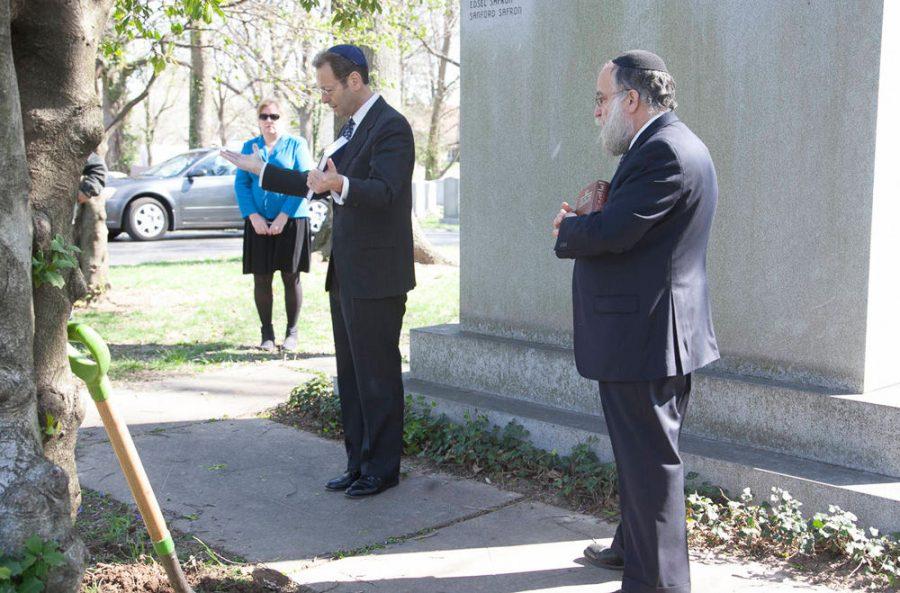Dachau victim’s remains laid to rest in St. Louis cemetery
Published April 3, 2016
Debra Cordy had heard for years that the remains of a Holocaust victim were somewhere in her parents’ house before she found them in 2014.
She knew that her father, William Elston, a U.S. soldier, had gone through the Dachau concentration camp at the end of World War II and was “appalled at what he saw.”
“He brought the small remains to show everyone at home that, yes, I was there. It did happen. This is what I saw,” said Cordy, who grew up in Rochester, N.Y., and lives in St. Louis.
On Sunday, she gathered with family members, representatives of the St. Louis Holocaust Museum and Learning Center, and Jewish clergy to bury the remains at Chevra Kadisha Cemetery in University City.
The circumstances surrounding the remains were highly unusual, a rabbi and a leader of the museum said. The rabbi credited divine providence.
Elston, who served in the war from 1943-45, died of a heart attack in 1983 at age 63. Cordy said her father had not told their family much about his time overseas.
“We knew that he had served,” said Cordy, 60. “We knew that he had seen a lot, but we didn’t really get an opportunity to speak to him, like we would have liked to, about it. He set everything aside.”
Cordy and her sister had looked for the remains in their childhood home but didn’t find them until two summers ago when they were moving their mother to an assisted living center. They found them in a small envelope onto which her dad had written “Dachau,” the camp in southern Germany where at least 28,000 prisoners died in the Holocaust.
“We knew they were sacred,” said Cordy, who is not Jewish. “We didn’t want to dispose of them. We grew up with the belief that everybody is the same, that you do not hold any prejudice.”
Cordy drove to St. Louis from New York with the envelope and reached out to Dan Reich, curator and director of education at the Holocaust museum in Creve Coeur. Reich said an archivist confirmed that the contents of the envelope were human remains.
Reich then had to figure out what to do with them. He did not think that displaying the remains in the museum was appropriate, but he also wanted to accept the donation because “clearly, the family was not comfortable having them in their home.”
He said the museum will sometimes receive Nazi materials from the families of World War II veterans.
“When they pass away, the family doesn’t necessarily want Nazi memorabilia in their home. They also don’t want it to fall into the wrong hands, so we accept it in our archives,” Reich said. “This was a more extreme case.”
He reached out to Rabbi Yosef Landa, director of Chabad of Greater St. Louis, who said the decision to bury the remains was a simple one.
“It didn’t seem like it was much of a question,” Landa said. “That’s what Jews do with remains.”
Still, he had never before encountered a similar situation.
“It’s completely unique,” Landa said. “I don’t think anything like this has ever possibly happened. You’re talking about remains of victims of the Holocaust left in Europe, 70 years later finding a burial place in St. Louis, in the middle of America.
“The providence of all of this happening is truly remarkable. We can’t understand it, but we take note of how extraordinary a moment it is.”
The remains were buried in accordance with Jewish law — in a wooden box with no hinges or anything that is not biodegradable — at a Jewish cemetery. But it is not a certainty that the victim was Jewish or even that the remains were from a single person, Landa said. The large majority of prisoners at Dachau were Jewish, but there were other political prisoners held there.
At the ceremony, Cordy, Reich and Landa each spoke. The rabbi also recited a few psalms and the Mourner’s Kaddish. He linked the remains to the Talmudic expression: “One who saves a single life, it is as if he has saved an entire world.”
“This concept comes into sharper focus on the day when we bury the remains of a nameless, unidentified victim of the Holocaust,” Landa said. “When the remains have no specific identify, we are forced to think of these remains not only as of one individual but rather these remains become representative and are symbolic of all the victims of the Holocaust who never received a dignified and proper burial.”
The remains were buried in front of a central marker at the cemetery. Reich said several people have expressed interest in marking the site.















